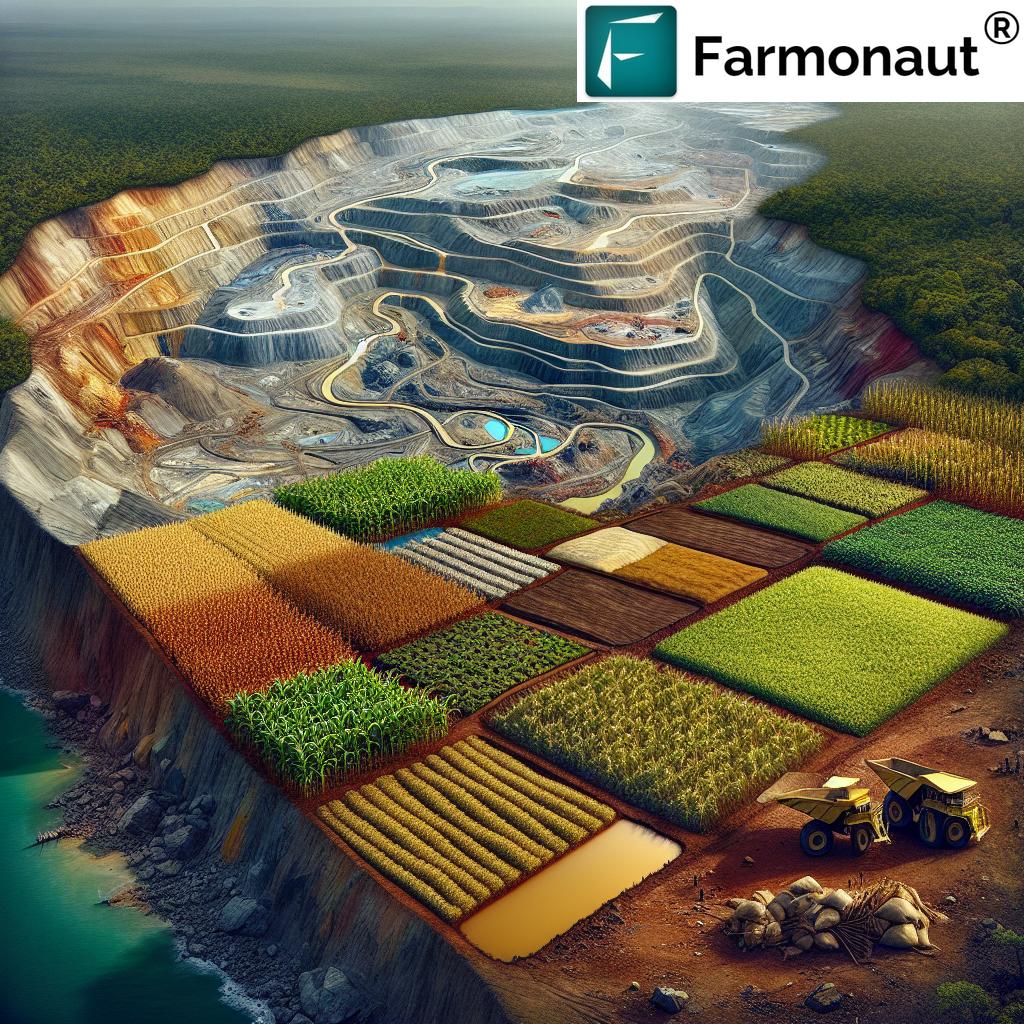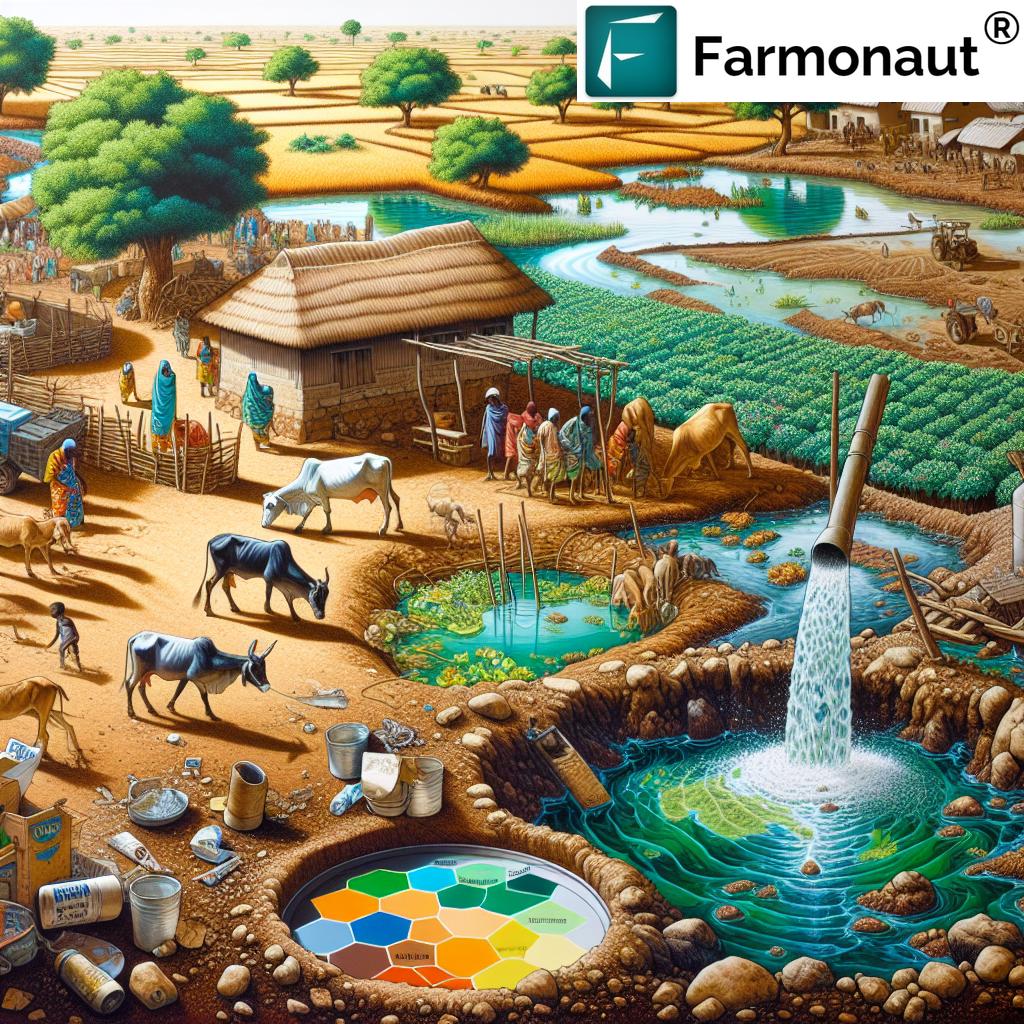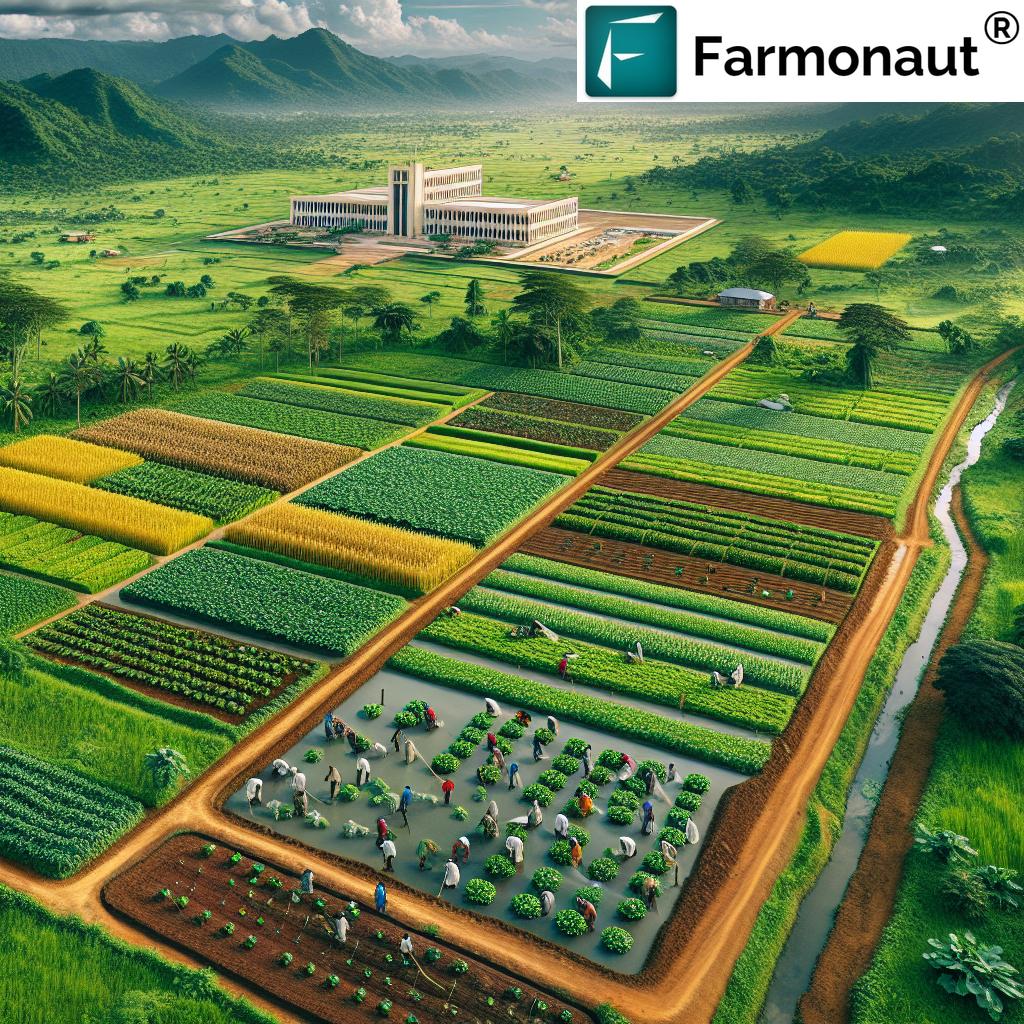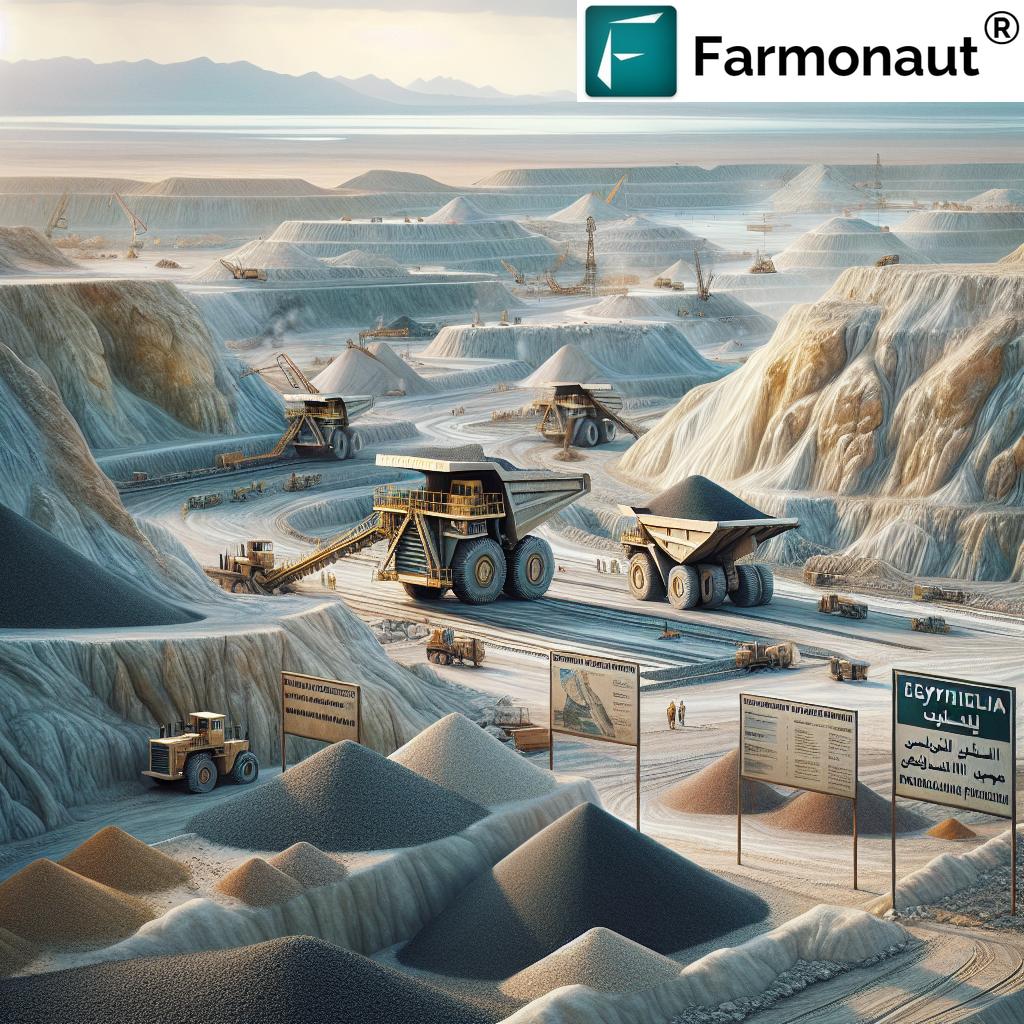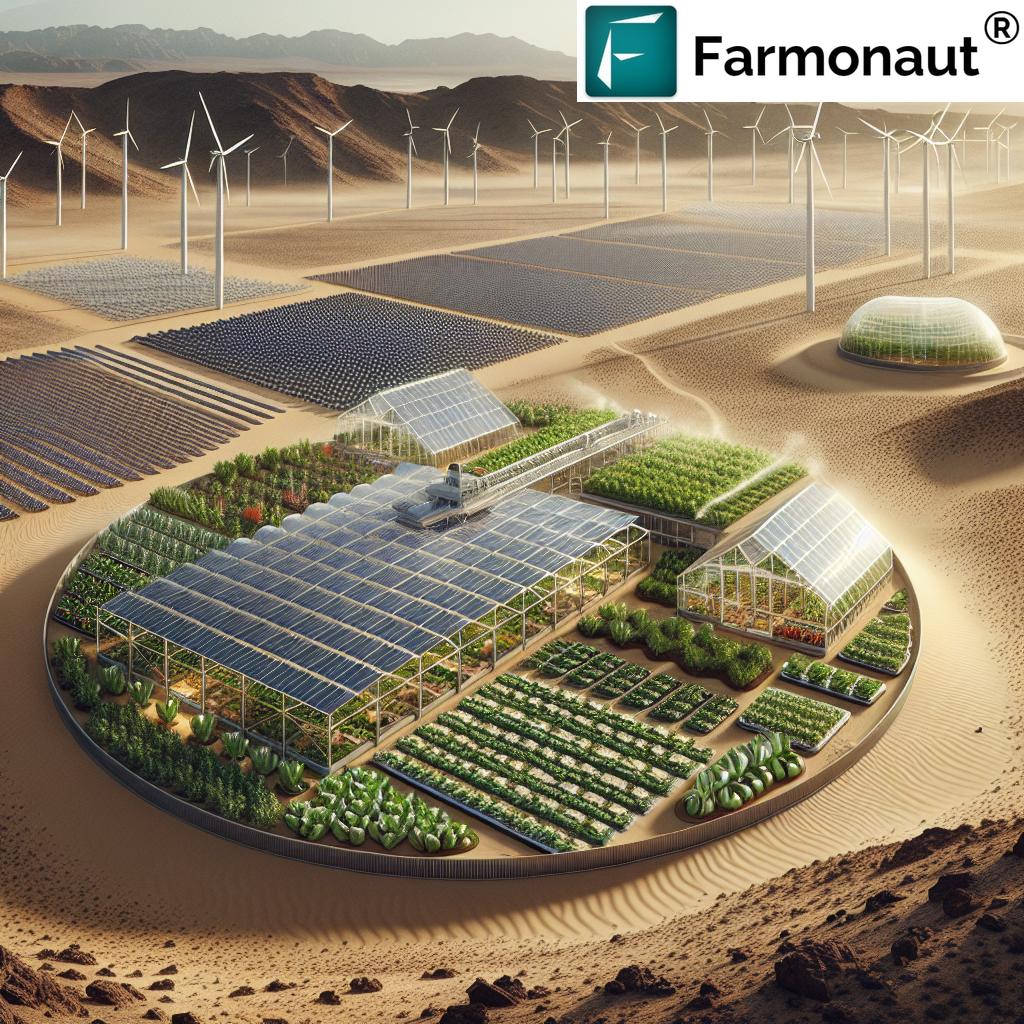Mining for Precious Metals: 7 Mali Farming Impacts
“Over 80% of Mali’s population relies on agriculture, yet mining activities threaten 30% of arable land with degradation.”
Table of Contents
- Introduction: Mining and Agriculture in Mali
- The 7 Key Farming Impacts of Precious Metal Mining in Mali
- Environmental Impacts of Mining in Mali
- Economic Impact of Mining on Rural Communities
- Social and Health Effects of Gold Mining on Local Communities
- Sustainable Mining Practices and Community Solutions
- Farmonaut’s Role: Sustainable Agriculture in Mining Regions
- Comparative Impact Table for Precious Metal Mining in Mali
- Frequently Asked Questions
- Conclusion
Introduction: Mining and Agriculture in Mali
As we explore the intricate relationship between mining and agriculture, particularly in Mali, we uncover a landscape marked by both opportunity and challenge. Precious metals—especially gold and silver—are central to Mali’s economic development and global economic activity. However, the extraction processes often intersect with traditional agricultural and livestock activities, generating a multifaceted web of environmental, economic, and social impacts.
The dual importance of agriculture and mining in Mali cannot be understated. Over 80% of Mali’s population depends on farming as their primary livelihood, while the mining industry contributes a significant proportion to the country’s GDP and export revenue. Yet, the co-existence of both sectors isn’t without issues—large-scale mining activities have reshaped landscapes, altered water cycles, and threatened both food security and community well-being.
This comprehensive exploration will examine the 7 key farming impacts of precious metal mining in Mali, providing actionable insights and well-researched facts tailored for agriculture and sustainability stakeholders, including local communities, rural farmers, policymakers, and those implementing advanced solutions like Farmonaut.
“Gold mining in Mali contributes to 20% of national water contamination, impacting both crops and local communities.”
The 7 Key Farming Impacts of Precious Metal Mining in Mali
Below we outline and deeply analyse seven critical impacts mining has on Mali’s farming sector, drawing from leading research, local sources, and sustainability expertise.
- Water Contamination from Mining
- Land Degradation Due to Mining Activities
- Mining Pollution and Soil Fertility Loss
- Crop Yield Reduction
- Community Health and Livestock Quality
- Economic Displacement and Livelihood Shifts
- Sustainable Practices Adoption and Limitations
Environmental Impacts of Mining in Mali
The environmental impacts of mining in Mali’s agricultural regions manifest in numerous ways: large-scale deforestation, water resource contamination, and extensive land degradation. Understanding these consequences is crucial for developing sustainable mining practices and protecting rural communities’ livelihoods.
Deforestation in Mining Regions: Scope and Effects
Mining operations in Mali often begin with clearing large tracts of forest, a process known as “deforestation.” This removal of forest is a direct result of siting mines, establishing transportation corridors, and creating space for waste and tailings deposits.
- Deforestation in mining regions disrupts local climates and cycles—altering rainfall, temperature, and humidity patterns.
- The destruction of habitats diminishes biodiversity, pushing many native species toward local extinction.
- Forests are central to regulating water cycles. Once removed, water runoff increases, leading to soil erosion and flooding in farmlands downstream.
- Research suggests mining activities accounted for significant forest loss (2005-2015) in tropical regions worldwide, including West Africa.
In the context of Mali, gold mining is primarily concentrated in the southwestern regions (notably around Sadiola, Morila, and Loulo). These forests support not only wildlife but also subsistence agricultural activities.
Water Contamination from Mining: Threat to Aquatic and Agricultural Systems
Water is a critical resource for both mining operations and agriculture. Unfortunately, mining processes introduce toxic pollutants through the extraction and processing of precious metals such as gold and silver.
- Mercury and cyanide are the two primary chemicals used in artisanal and industrial gold mining. Both substances can leach into water bodies, contaminating rivers, streams, and groundwater.
- Contaminated water directly impacts irrigation, compromising crop health and food safety.
- Local communities that depend on water for drinking and bathing—along with livestock foraging—face increased toxicity and negative health effects.
- Concrete examples from other regions, such as the 2015 Gold King Mine wastewater spill in Colorado, illustrate the scale and duration of these problems. In Mali, similar concerns have emerged due to increased mining activity.
In Mali, it’s estimated that gold mining activity contributes to at least 20% of the country’s water contamination. This places immense stress on agriculture and the aquatic ecosystems in the region, with downstream effects on crop yields and food safety.
Land Degradation Due to Mining Activities
The most visible effect of mining on agricultural lands in Mali is land degradation. This occurs via multiple mechanisms:
- Excavation and open-pit mining: Physical removal of soil layers destroys the structure and fertility of agricultural land.
- Soil Erosion: With the removal of native vegetation and topsoil, wind and rain carry away the remaining fertile layer. Studies (such as those near the Ok Tedi Mine in Papua New Guinea) show how sediment-laden runoff can travel for kilometers, degrading farmlands and riverbanks.
- Waste and tailings storage: Large waste dumps often encroach onto arable land, further reducing space for cultivation.
The result is a permanent loss of productive land, undermining the agricultural foundations of rural communities already facing food and economic insecurity. In many rural villages, this land degradation means less land for farming, pasture, and natural regeneration.
Looking for precise monitoring of your agricultural land’s soil and crop health—even in mining-impacted areas? Discover Farmonaut’s large-scale farm management tools for actionable, satellite-driven insights on land productivity and restoration.
Mining Pollution and Soil Fertility
Another major consequence of mining and agriculture overlap in Mali is the loss of soil fertility. Soil pollutants released during gold extraction processes—such as mercury, cyanide, and heavy metals—degrade the quality and productivity of both crop fields and pastures.
- Contaminated soil reduces crop yield and limits what farmers can grow—especially root crops and vegetables sensitive to toxicity.
- Research has shown elevated heavy metal content in livestock and produce grown near mining sites, affecting both food safety and marketability (see reference studies on livestock and heavy metals).
- Soil erosion caused by mining activities removes essential organic matter, making soil rehabilitation a slow, costly process. Once lost, topsoil may take decades or longer to rebuild naturally.
In Mali’s most affected regions, up to 30% of arable land may experience moderate to severe fertility loss due to mining pollution—a significant challenge for traditional agricultural livelihoods.
Economic Impact of Mining on Rural Communities
While mining is heralded as a vital contributor to the national economy in Mali, its economic effects on rural and agricultural communities are layered and complex.
Dual-Edged Economic Effects of Mining in Mali
- Job Creation: Mining operations (notably gold mines in Sadiola, Morila, and Loulo) generate direct employment, infrastructure improvements, and revenue. These jobs, however, are often temporary and geographically limited.
- Land Displacement: Acquisition of land for mining can fragment or eliminate traditional agricultural landholdings. When farmers are displaced, they may have few viable alternatives for earning a living.
- Water Resource Competition: Precious metal extraction is water-intensive, often creating shortages for local agriculture and livestock, especially during the dry season.
- Migration & Urbanization: Rural-urban migration increases as people seek jobs in the mining sector, abandoning farming and altering the demographic and labor profile of villages.
A 2023 estimate suggests that up to 10% of Mali’s rural workforce has shifted from agriculture to mining activities within major mining corridors, fundamentally reshaping farming communities and their long-term stability.
To support sustainable economic resilience, rural communities may benefit from tools that verify land ownership and monitor crop status for crop loans and insurance. Farmonaut’s solutions support rural economies by providing satellite-based land verification and risk assessment, facilitating better access to credit and protecting agricultural livelihoods.
Social and Health Effects of Gold Mining on Local Communities
Social impacts from the mining–agriculture nexus are profound in Mali. The most critical issues include health concerns, resource conflict, and social displacement.
Resource Conflict and Land Rights
- Competition for land: As mining activities expand, land traditionally allocated for crops or livestock grazing is repurposed for mineral extraction. This creates friction not only among local villages but also within families (for example, disputes over inherited land now subject to mining leases).
- Water rights: Local communities, often with limited legal recourse, can lose access to vital water sources diverted for mining use. There have been reported protests and tensions near the Sadiola gold mine over water shortages and contamination.
- Loss of communal spaces: Displacement means rural villagers often lose key cultural and social spaces critical to community coherence and resilience.
Health Concerns Linked to Mining Pollution
- Direct exposure: Communities living adjacent to mines are at risk of inhaling dust laden with heavy metals, drinking contaminated water, and consuming crops and livestock that have accumulated mercury, cyanide, or other toxins.
- Livestock health: As livestock graze near contaminated water bodies, the pollutants not only reduce animal productivity but make their meat and milk unsafe for human consumption.
- Research in other mining regions (e.g., Mongolia) found high concentrations of heavy metals in animals, impacting food chains and human health.
Food safety, community health, and land tenure security are now urgent issues for affected regions. Implementing responsible resource management and transparent land-use monitoring is central to promoting healthy, resilient rural communities in the face of mining expansion.
Sustainable Mining Practices and Community Solutions
Emerging best practices in Mali and around the world highlight clear pathways to reconcile mining and agriculture—balancing economic benefits with environmental and community well-being. Our sustainable future depends on informed, technology-enabled decision-making.
Mitigation Strategies for Environmental and Social Protection
- Stronger environmental regulations: Enforce limits on toxic substance discharge, mandate reforestation, and require state-of-the-art waste management systems to mitigate mining pollution.
- Land reclamation and reforestation: Restore mined lands to productive use, improving soil fertility and landscape diversity over time. Projects focusing on replanting native species are gaining traction.
- Community engagement: Put local communities at the center of decision-making. Empowering residents ensures their voices shape land use, compensation, and restoration schemes.
- Technology adoption: Use satellite imagery and remote sensing data for transparent monitoring, early warning, and adaptive management. For instance, Farmonaut’s advanced monitoring tools can detect crop stress, track land use changes, and verify carbon sequestration, paving the way for measurable, sustainable development.
We recommend leveraging digital tools for product traceability. Farmonaut’s blockchain-based traceability platform allows supply chain stakeholders to confirm the origins and journey of agricultural produce, reinforcing trust in food safety and fair trade.
Pathways to Sustainable Agriculture in Mining-Impacted Regions
- Carbon footprint reduction: Monitor and cut emissions on-farm and in the supply chain. Explore Farmonaut’s carbon footprinting features for actionable sustainability metrics tailored for Mali and other mining-influenced areas.
- Economic resilience: Diversify rural economies toward sustainable agriculture, rural services, and eco-friendly practices to buffer against commodity price swings and mining sector changes.
- Policy integration: Combine land tenure, water management, and environmental stewardship policies to effect systemic change in resource allocation and conflict management.
Farmonaut’s Role: Sustainable Agriculture in Mining Regions
As we strive to resolve the tensions between mining and agriculture, Farmonaut’s satellite and AI-powered solutions empower farmers, agribusinesses, and communities in Mali to thrive even in the face of mining’s challenges.
Farmonaut Technologies for Impacted Regions
- Satellite-Based Crop Health Monitoring: Detect real-time vegetation stress, moisture imbalance, and land use changes, enabling timely interventions even near or within mining-impacted landscapes.
- Jeevn AI Advisory: Personalized, data-driven farm management advice takes into account hyperlocal weather, soil, and crop conditions, helping farmers maintain productivity and resource efficiency.
- API & Developer Tools: Integrate reliable remote sensing data directly into agricultural management systems, supporting researchers and agribusinesses seeking scalable, sustainable solutions.
- Fleet management for logistics optimization ensures responsible use of agricultural machinery, even in regions where resource constraints or terrain have shifted following mining activities.
- Carbon Footprinting: Continuously track and reduce environmental impact across operations—vital for those near mining activities keen to demonstrate sustainability leadership.
Farmonaut is not a regulatory body, manufacturer, or online marketplace, but a technology enabler—making advanced, affordable precision agriculture accessible to all. Whether you’re a farmer seeking to restore soil quality, a business leader tracking supply chain authenticity, or a policy advisor building future-ready land management plans, Farmonaut provides robust APIs and easy-to-use platforms across Android, iOS, and web—unlocking data for sustainability.
For more information, check out Farmonaut’s subscription options tailored for every farm size and need:
Comparative Impact Table for Precious Metal Mining in Mali
To distill and clarify the wide-ranging effects of mining on Mali’s farming sector, view the comparative table below. This enables both rapid understanding and accurate SEO keyword coverage for searchers looking to compare impacts across water contamination, land degradation, and sustainable recovery.
| Impact Area | Estimated Severity (Low/Medium/High) | Estimated % of Farmland Affected | Description/Example |
|---|---|---|---|
| Water Contamination | High | 20%-30% | Heavy metals (mercury, cyanide) leach into rivers and groundwater, contaminating irrigation water and affecting aquatic & agricultural systems near mines. |
| Land Degradation | High | 20%-35% | Excavation and waste storage cause erosion and reduce land productivity, fragmenting arable landholdings in mining regions. |
| Soil Fertility Loss | Medium | 25%-30% | Toxic chemicals lower soil quality, reducing yields, and affecting crop/livestock health, especially in top agricultural corridors adjacent to mines. |
| Crop Yield Reduction | Medium | 18%-22% | Stress from water and soil contamination decreases productivity, with root crops and vegetables most impacted. |
| Community Health | High | 20%-30% of population near mines | Incidence of respiratory, skin, and digestive illnesses increases as exposure to mining pollutants rises in impacted communities. |
| Economic Displacement | Medium | 10%-15% | Agricultural workers migrate to mining jobs, reducing local food production and altering rural economies & traditions. |
| Sustainable Practices Adoption | Low (improving via tech) | 5%-10% | Community and business adoption of sustainable farming and reclamation practices rises with advanced solutions like satellite monitoring (Farmonaut). |
“Gold mining in Mali contributes to 20% of national water contamination, impacting both crops and local communities.”
Frequently Asked Questions (FAQ)
1. How does mining affect agriculture in Mali?
Mining operations consume large tracts of land, contaminate water resources, and release pollutants that reduce soil fertility—threatening crop yields and rural livelihoods. Deforestation, disrupted water cycles, and economic displacement are common.
2. What are the main pollutants from gold mining operations?
Mercury and cyanide are prominent. Heavy metals and by-products from ore processing accumulate in soil and water, impacting both crops and livestock health.
3. Is there a way to monitor land quality and restore agricultural productivity?
Yes. Platforms like Farmonaut use satellite and AI technologies to monitor crop health, soil fertility, and land use changes. These tools guide targeted interventions for land restoration and sustainable farming practices even in post-mining landscapes.
4. How are local communities impacted beyond the environment?
Mining can lead to the loss of ancestral lands, reduced access to water, rising health problems (due to pollutants), and changes in community livelihoods as people migrate to mining for work.
5. What role does Farmonaut play in supporting sustainable agriculture?
Farmonaut provides affordable, satellite-based services for real-time farm monitoring, crop management, traceability, and carbon footprinting. By making precision agriculture accessible, it helps communities adapt to challenges from mining, track environmental recovery, and build resilient livelihoods.
6. How can I access Farmonaut’s solutions for my land or business?
You can use Farmonaut’s web, API, Android, and iOS apps to monitor your farmland, track environmental indicators, or integrate data into your agribusiness. Visit the app links above or explore Farmonaut’s API Documentation.
Conclusion
Mining for precious metals in Mali brings a complex interplay of opportunity and risk—boosting the national economy while placing mounting pressures on agricultural land, water, and local communities. Environmental impacts of mining, including deforestation, water contamination, land degradation, and declining soil quality, threaten food security and traditional livelihoods for Mali’s rural population.
Yet, there are clear pathways forward. We believe adopting sustainable mining practices, enforcing robust environmental regulations, and empowering rural communities are essential to a balanced, resilient future. Technology—especially satellite-based, AI-driven agricultural solutions from Farmonaut—offers a practical way to monitor, restore, and optimize Mali’s farmlands for generations to come.
Let us strive for a Mali where precious metal wealth does not come at the cost of our agricultural future. With knowledge, stewardship, and innovation, we can forge a sustainable path, protecting both economic development and the land that feeds us all.
Ready to act? Download the Farmonaut app, explore our web dashboard, or learn about our APIs to take the first step towards resilient, sustainable agriculture in your community today.


